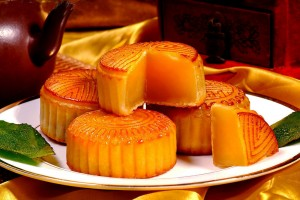| Home > China Feature |
Happy Middle-Autumn Day 欢度中秋
“Zhong Qiu Jie”, which is also known as the Mid-Autumn Festival, is celebrated on the 15th day of the 8th month of the lunar calendar. It is a time for family members and loved ones to congregate and enjoy the full moon – an auspicious symbol of abundance, harmony and luck. Adults will usually indulge in fragrant mooncakes of many varieties with a good cup of piping hot Chinese tea, while the little ones run around with their brightly-lit lanterns.
“Zhong Qiu Jie” probably began as a harvest festival. The festival was later given a mythological flavour with legends of Chang-E, the beautiful lady in the moon.

According to Chinese mythology, the earth once had 10 suns circling over it. One day, all 10 suns appeared together, scorching the earth with their heat. The earth was saved when a strong archer, Hou Yi, succeeded in shooting down 9 of the suns. Yi stole the elixir of life to save the people from his tyrannical rule, but his wife, Chang-E drank it. Thus started the legend of the lady in the moon to whom young Chinese girls would pray at the Mid-Autumn Festival.
Mid-Autumn Day is a traditional festival in China. Almost everyone likes to eat mooncakes on that day. Most families have a dinner together to celebrate the festival. A saying goes, “The moon in your hometown is almost always the brightest and roundest”. Many people who live far away from homes want to go back to have a family reunion. How happy it is to enjoy the moon cakes while watching the full moon with your family members.
“中秋”一词,最早见于《周礼》。根据我国古代历法, 汉服中秋农历八月十五日,在一年秋季的八月中旬,故称“中秋”。一年有四季,每季又分孟、仲、季三部分,因此秋中第二月叫仲秋,到唐朝初年,中秋节才成为固定的节日。《新唐书·卷十五 志第五·礼乐五》载“其中春、中秋释奠于文宣王、武成王”,及“开元十九年,始置太公尚父庙,以留侯张良配。中春、中秋上戊祭之,牲、乐之制如文”。据史籍记载,古代帝王祭月的节期为农历八月十五,时日恰逢三秋之半,故名“中秋节”;又因为这个节日在秋季八月,故又称“秋节”、“八月节”、“八月会”、“中秋节”;又有祈求团圆的信仰和相关习俗活动,故亦称“团圆节”、“女儿节”。因中秋节的主要活动都是围绕“月”进行的,所以又俗称“月节”、“月夕”、“追月节”、“玩月节”、“拜月节”;在唐朝,中秋节还被称为“端正月”。中秋节的盛行始于宋朝,至明清时,已与元旦齐名,成为我国的主要节日之一。关于中秋节的起源,大致有三种:起源于古代对月的崇拜、月下歌舞觅偶的习俗,古代秋报拜土地神的遗俗。
Art
 more
moreChina Beijing International Diet ...
Recently, The hit CCTV documentary, A Bite of China, shown at 10:40 ...

Exhibition of Ancient Chinese Jad...
At least 8,000 years ago, Chinese ancestors discovered a beautiful...

Longmen Grottoes
The Longmen Grottoes, located near Luoyang, Henan Province, are a tr...

Custom
 more
moreWeb Dictionary
Martial Arts
Tai Chi Master Class Held in Moscow
MOSCOW, June 15, 2016 (Xinhua) -- Students learn from Shaolin ...
Celebriting 70 years' efforts in restoring Mogao...
Work is being carried out at the restoration site of cave No 98 a...
Hong Kong Children's Symphony performs in Seattle
Under the theme of Tribute to the Golden Age, a concert featuring a ...





 print
print  email
email  Favorite
Favorite  Transtlate
Transtlate 








